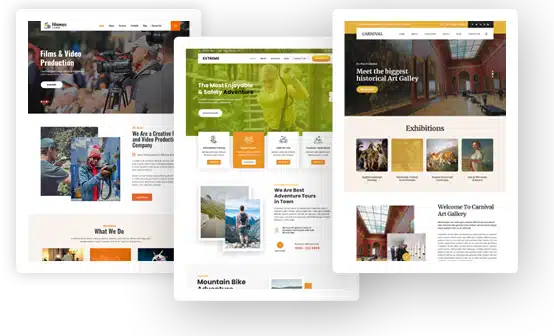How to Choose the Perfect WordPress Theme for Your Brand

Your website is often the first place customers interact with your brand. In just a few seconds, visitors form an opinion about your business based on how your site looks, how it functions, and how easily they can find information.
A well-chosen WordPress theme can set the right tone from the start, showcasing your brand identity, delivering a smooth browsing experience, and supporting your long-term growth goals.
With thousands of free and premium themes available, the choices can feel overwhelming. But when you focus on a few key factors, you can confidently select a theme that’s not only visually appealing but also aligned with your brand’s personality, your audience’s needs, and your business objectives.
Understand Your Brand’s Personality
The best website designs reflect the personality of the brand they represent. Before browsing themes, think about the qualities you want your brand to communicate.
Are you aiming for a clean and modern feel, a bold and energetic look, or a warm and inviting style?
The right theme will incorporate elements like typography, color schemes, and layout styles that match your brand’s tone.
For example:
- A technology company might prefer a sleek, minimalist theme with cool tones and structured layouts.
- A creative agency might choose a vibrant, image-heavy theme with dynamic design elements.
- A lifestyle brand might opt for soft colors, generous white space, and a relaxed flow.
When your website design matches your brand’s personality, it feels authentic to visitors and strengthens their connection to your business. The eCommerce, business, portfolio website or News Portal Development Company can ensure that design, functionality, and user experience work seamlessly together to engage readers and build trust.
Prioritize a Responsive Design
Your audience is browsing on different devices: desktops, tablets, and smartphones. A theme with a responsive design automatically adapts to any screen size, keeping your site functional and attractive no matter how it’s viewed.
Mobile responsiveness is also a factor in search engine rankings. A site that works seamlessly on mobile devices creates a better user experience and can help improve your visibility in search results. Test a theme’s responsiveness by resizing your browser window or using online preview tools to see how it adapts to different screens.
Look for Strong Customization Options
Even a great-looking theme will need tweaks to fully match your brand. Flexible customization options let you adjust colors, fonts, layouts, and other design details without needing advanced coding skills. Many modern WordPress themes include drag-and-drop page builders, which make it easy to create unique page layouts.
Good customization features mean you can evolve your site as your brand grows, updating visuals, adding new sections, or changing layouts without having to switch themes entirely.
Ensure Compatibility with Essential Plugins
Plugins extend the functionality of your WordPress site, from adding contact forms and SEO tools to integrating e-commerce features. The theme you choose should be compatible with the plugins you rely on, both now and in the future.
If your site is for a specific industry, like retail, healthcare, or even manufacturing erp providers, compatibility becomes even more important. The right theme should integrate smoothly with tools and plugins that support your industry needs, ensuring your website works just as well for specialized audiences as it does for general visitors.
Pay Attention to Loading Speed
Website speed is a critical factor in user experience. Visitors expect fast-loading pages, and delays can lead to higher bounce rates. The theme you choose should be optimized for speed with clean, efficient coding and lightweight design elements.
When browsing theme options, check for speed-related claims from the developer and read user reviews to see if slow performance is a common issue. You can also test demo sites with tools like Google PageSpeed Insights to get a better idea of their performance.
Choose a Theme with Regular Updates and Support
WordPress itself is updated regularly, and your theme needs to stay compatible with the latest version to remain secure and functional. Look for themes backed by active developers who provide regular updates and respond to user feedback.
Access to reliable customer support is also important, especially during the early stages of customizing your site. Many premium themes include dedicated support channels, which can save you time and frustration if you run into technical issues.
Consider User Experience from Start to Finish
A theme isn’t just about how it looks; it’s also about how it feels to navigate. The design should make it easy for visitors to find what they’re looking for, whether that’s your contact information, product listings, or service details.
Clear navigation menus, well-structured layouts, and readable typography all contribute to a positive user experience. When people can navigate your site effortlessly, they’re more likely to stay longer, explore more pages, and return in the future.
Review Demo Content Carefully
Most theme providers offer demos so you can see the design in action. Don’t just look at the images, imagine your content replacing the demo text and visuals.
Does the structure still work?
Can you see your brand’s colors and images fitting naturally into the layout?
By visualizing your actual content within the theme, you’ll have a better idea of whether it’s the right match for your needs.
Balance Style with Functionality
It’s easy to be swayed by a visually stunning theme, but design alone won’t keep visitors engaged. Your theme should support the features your business needs now, as well as those you might need later.
For example:
- Service-based businesses might need booking or scheduling features.
- Creative professionals might prioritize portfolio display options.
- Online retailers will need strong product page layouts and checkout flows.
Balancing style with functionality ensures your website is not just beautiful but also a powerful tool for your business.
Conclusion
Choosing the perfect WordPress theme for your brand is about finding the right balance between visual appeal, usability, and flexibility. A good theme reflects your brand’s personality, works seamlessly across devices, supports your required features, and provides a smooth, enjoyable experience for visitors.
By focusing on elements like responsiveness, customization, speed, and user experience, you’ll create a website that not only looks professional but also actively supports your goals. The right theme becomes more than just a design choice; it becomes a foundation for building trust, engaging your audience, and growing your brand.

